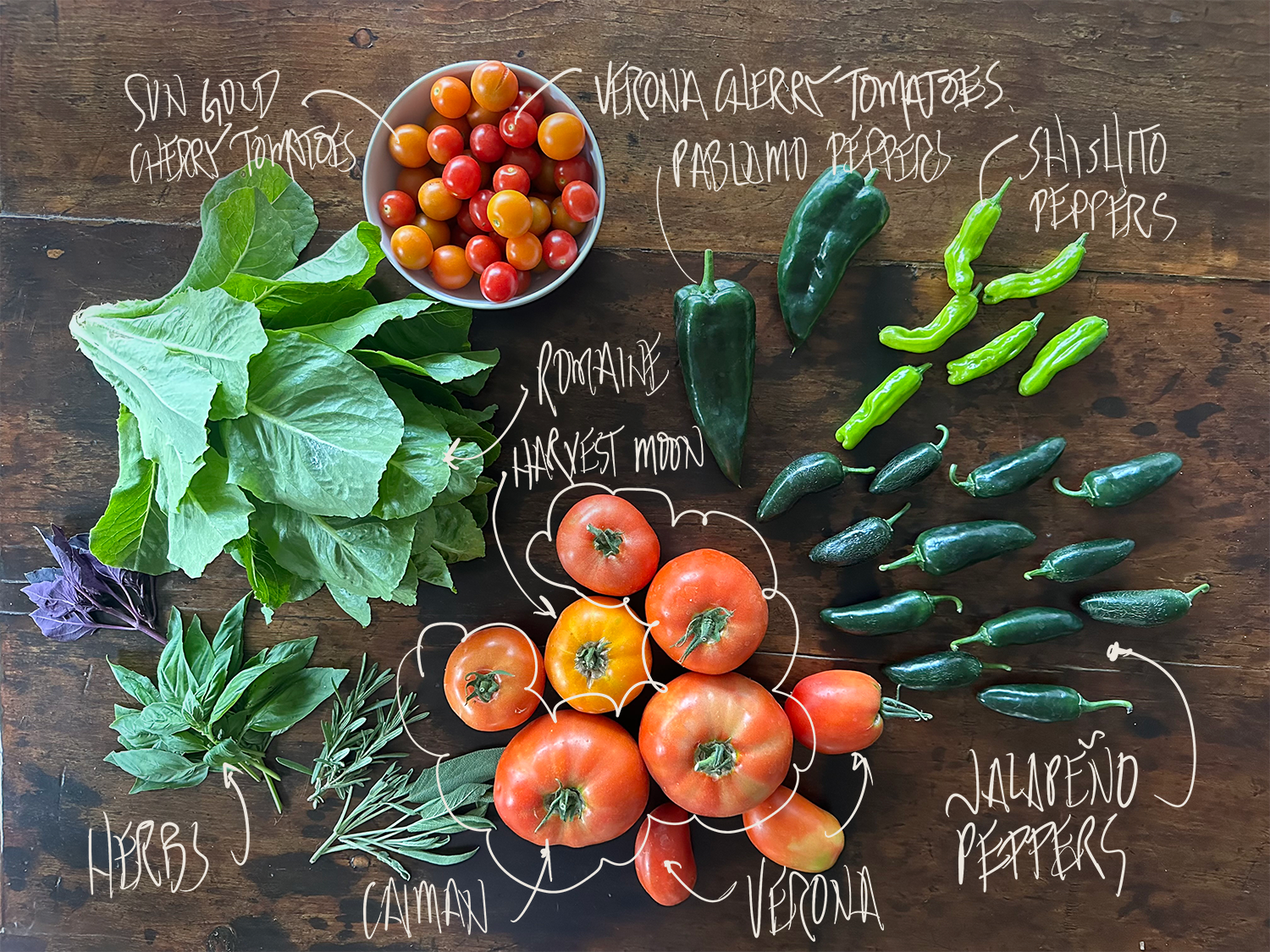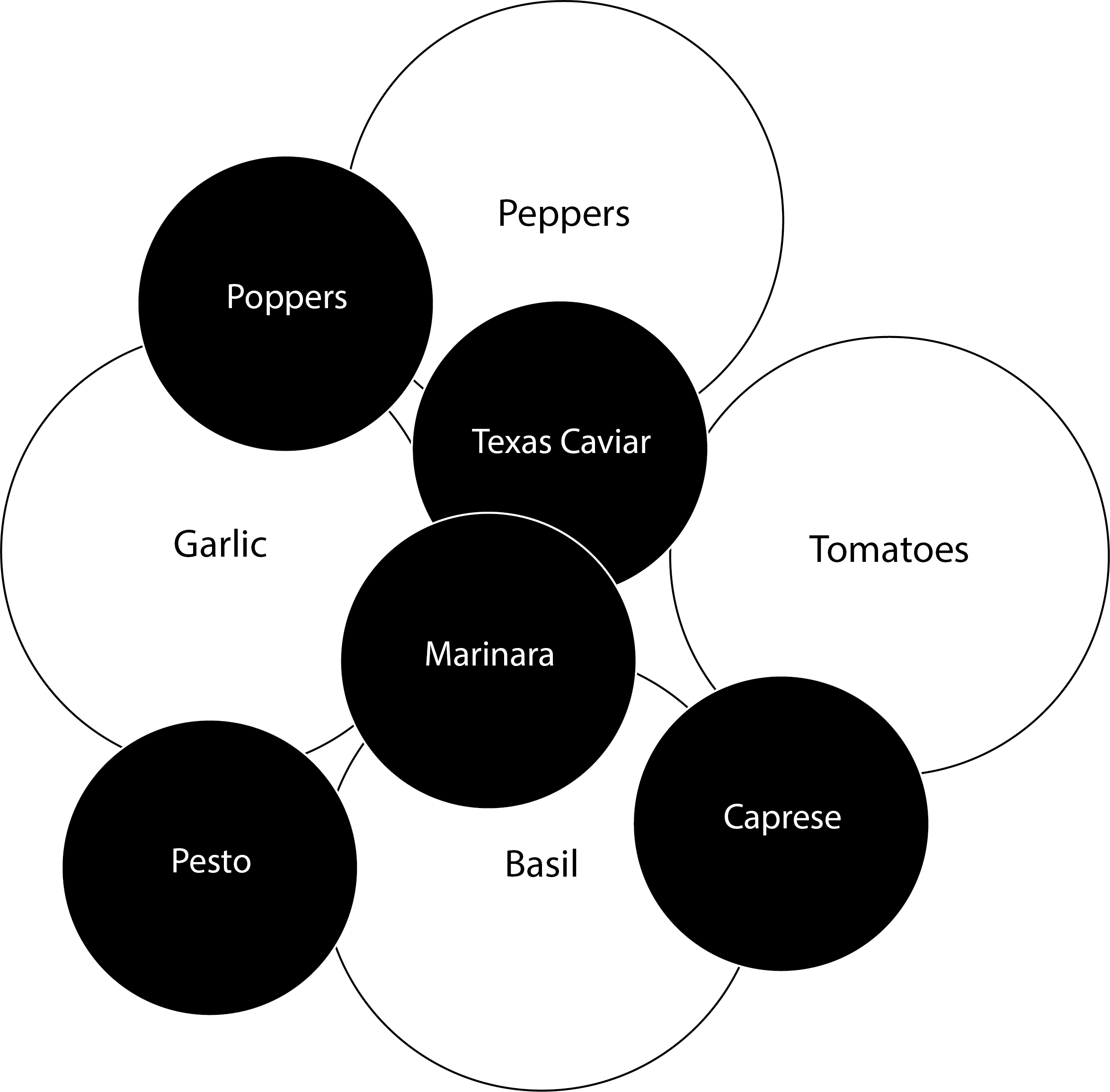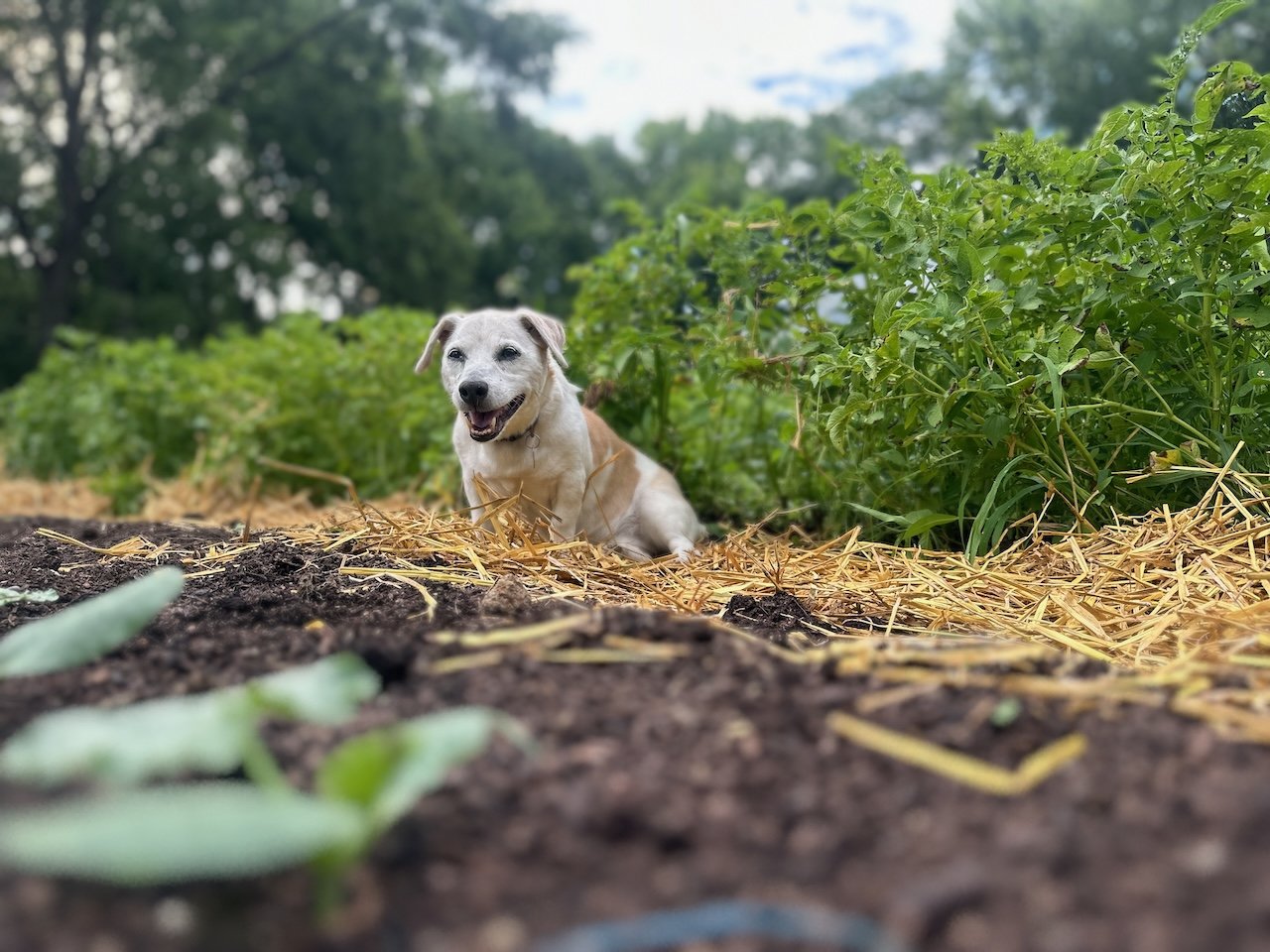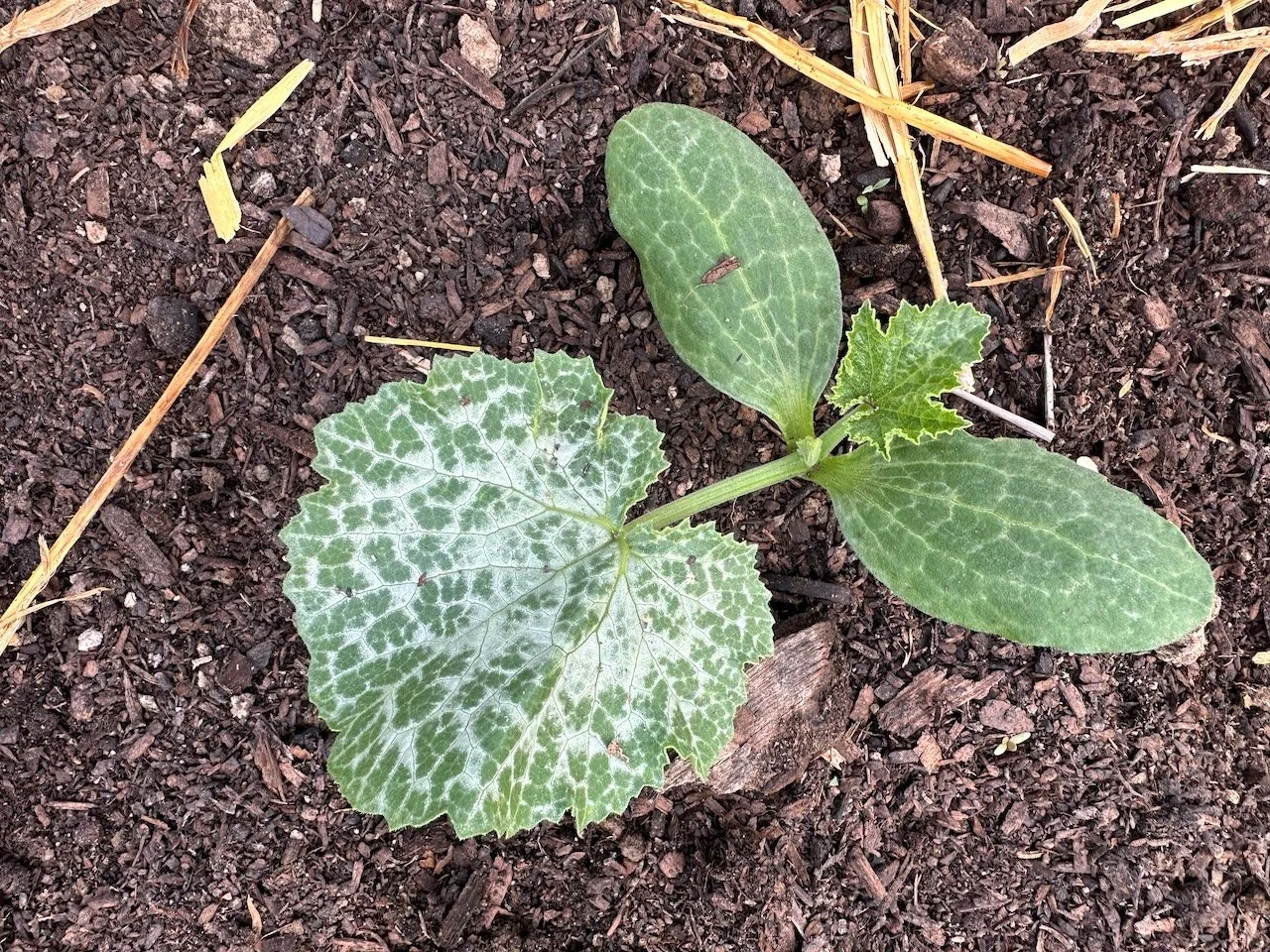2024 Summer | Week 5
Decisions, Decisions
This week's crate has ingredients for many of my favorite things. The ideas above are just a starter. For the next few weeks, we will be heavy on tomatoes, peppers, basil, and, of course, our latest garlic haul. These four ingredients open the door to some of the best things about eating fresh and local. Add to that a nice head of romaine, and the sky is the limit. Have fun experimenting, and let us know how you are using the latest bounty.
We are growing 5 varieties of tomatoes (all represented this week) and 5 varieties of peppers (only three are ready so far). Look at the varieties below and learn a little about where and how to use them.
Meet the Peppers
(descriptions from Johnny's Seeds)Poblano Pepper —Sturdy, upright plants produce high yields of uniform, 5" smooth, mostly two-lobed fruits. Bastan's fruits may be used at the green unripe or brown ripe stages. Excellent fried, roasted, or in chile rellenos.
Shishito Pepper—Avg. 3–3 1/2" fruits are thin-walled and have no heat. Popular in Japan, where its thin walls make it particularly suitable for tempura. Also very good roasted, in stir-fries, or sautéed. In Asia, the fruits are always cooked green, but they may also be used red. Thinly sliced, the red, slightly sweet fruits are excellent in salads and cole slaws.
Jalapeño Pepper—Beautiful, black jalapeno with floral flavor, mild spice and impressive yields. Plants are of manageable size and are very vigorous. At peak production, plants are covered in near black, dark green, thick walled fruit of perfect processing size. The gorgeous colored fruits stand out from the medium green plants making for easy harvest. Fruit has high visual impact due to unique, dark coloration.
Meet the Tomatoes
(descriptions from Johnny's Seeds)Caiman—From its excellent disease resistance package to its compact but high-vigor plant and consistent fruit set, Caiman is a strong performer in the tunnel. Beautiful, clean fruit on nicely sized trusses. Compared to Bigdena, Caiman is earlier, a bit more variable in size, and produces fruits with a more traditional beefsteak shape. Earlier maturity than Geronimo with good size potential. Indeterminate. USDA Certified Organic.
Harvest Moon—Firm, consistently sized (7–10 oz.), golden fruits. Fewer defects and oversized fruits than the heirlooms it imitates. Offers a sustained harvest with terrific fruit set all the way up the plant. Beautiful red blush internal color. Compact indeterminate plants with a more balanced habit, well-suited for basket-weave systems. Bred by Emily Rose Haga at Johnny's. Indeterminate. USDA Certified Organic.
Verona—Similar to Juliet, but with even tastier, somewhat more plump, deep red "cocktail plum" fruits averaging 2 1/2 oz. Long clusters on a medium-vigorous vine. Indeterminate. USDA Certified Organic.
Jasper—Round, 7–10 gm. fruits are crack resistant, borne on small trusses, and store on the plant well, resisting cracking and rot. The texture is pleasantly chewy, and the flavor is sweet and rich. Plants are extra vigorous and tall, staying healthy for a long picking period. Indeterminate. AAS Winner. USDA Certified Organic.
Sun Gold—Intense fruity flavor—Exceptionally sweet, bright tangerine-orange cherry tomatoes leave everyone begging for more. Vigorous plants start yielding early and bear right through the season. Tendency to split precludes shipping, making these an exclusively fresh-market treat. The taste can't be beat. 15–20 gm. fruits. Indeterminate.
Ruche oversees the squash planting this week.
Squash babies— I love the leaf shapes and colors/
What's in Your Crate this Week?
-
PEPPERS 101 - Whether hot or sweet, peppers are full of beneficial vitamins and minerals and are great raw or cooked. They can be sliced on pizzas or as part of salads and even stuffed with meats and cheeses. Hotter peppers like jalapeños can be cooked or roasted to reduce their heat. They make a great addition to any meal such as: sandwiches, tacos, pizzas, or chopped and added to soups, stews, sauces and more. Our personal favorite, are Jalapeño Poppers.
EAT NOW - First rinse and dry your peppers. Cut off the top and slice. If preparing hot peppers, be careful to wash your hands after handling - don’t touch your eyes! For less spicy peppers, cut in half length-wise and remove seeds and ribs. Are best stored whole.
OR LATER - Store whole or sliced in fridge for up to 1 week. To store longer, flash freeze (whole or sliced) on a cookie sheet. Transfer to a freezer bag once frozen. They keep well in the freezer – no need to thaw for use in cooked dishes.
RECIPES
-
TOMATOES 101 - Probably the most versatile fruit in the garden, tomatoes can be used in countless ways - salsa, gazpacho, sauces, slow roasted, puree and even a bloody Mary. Ours are grown for taste so eat them right out of the crate.
EAT NOW - Store unripe tomatoes upside down on a plate at room temperature until they fully ripen. Wash, pat dry, slice or dice, and enjoy the taste of a real tomato.
OR LATER - Refrigerate any fully ripe tomatoes - allow to come to room temp before serving. To freeze, first blanch and dunk in ice water to cool. Remove stems and core. Transfer to storage bags, seal and place in freezer.
To blanch, bring a pot of lightly salted water to a rolling boil. While you wait for boil, prepare an ice bath. Once boiling, drop veggies into water - water should return to boil within a minute otherwise you have too much veg for the water. Once boil has returned, cook for 1-5 min until veg has a vibrant color. Immediately put into ice bath to stop cooking.
RECIPES
-
Item description




